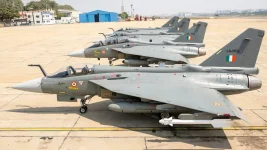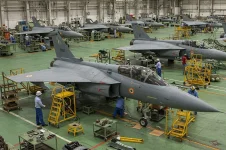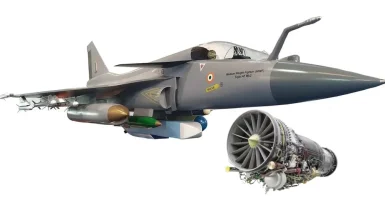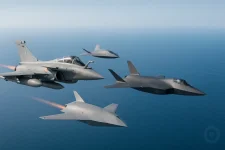- Views: 2K
- Replies: 8
The selection process for the production partner of India's ambitious fifth-generation stealth fighter, the Advanced Medium Combat Aircraft (AMCA), has reached a critical phase.
With seven consortia in contention, the decision will determine the future of the nation's air combat capabilities and its journey toward self-reliance in defence manufacturing.
The Aeronautical Development Agency (ADA), which leads the aircraft's design, is overseeing a rigorous two-stage evaluation of the bids.
Initially, a committee of senior officials from the Defence Research and Development Organisation (DRDO) will assess the technical and manufacturing capabilities of each applicant.
Their recommendations will then be forwarded to a high-level panel, chaired by the Defence Secretary, for the final decision.
High Stakes and Strict Requirements
This meticulous selection process is designed to identify a partner capable of meeting the project's demanding goals.The chosen consortium will be responsible for producing an estimated 126 aircraft for the Indian Air Force (IAF), a project valued at over ₹15,000 crore (approximately $1.8 billion).
Key requirements include achieving a 70% indigenous content level, ensuring the seamless integration of critical homegrown technologies like the Uttam Active Electronically Scanned Array (AESA) radar, and maintaining cost-efficiency.
The decision is strategically vital for the IAF, which currently operates with approximately 31 fighter squadrons against a sanctioned strength of 42.
The AMCA is expected to enter service by 2035, helping to bridge this gap with a state-of-the-art platform.
The initial DRDO review will scrutinise each bidder's expertise in areas essential for a stealth fighter, such as the use of radar-absorbent materials, advanced composite structures, and engines capable of supercruise (supersonic flight without afterburners).
This technical evaluation, expected to conclude by early 2026, will be followed by a strategic review from the Defence Secretary's panel, which will also consider factors like export potential under the Defence Acquisition Procedure (DAP) 2020.
A Field of Aerospace Titans
The competition features a mix of public sector undertakings and private industry leaders, each presenting unique advantages for the complex AMCA project. The primary contenders include:- Hindustan Aeronautics Limited (HAL): As the manufacturer of the Tejas Light Combat Aircraft, HAL possesses unmatched experience in aircraft assembly, integration, and certification in India.
- Tata Advanced Systems Limited (TASL): Known for its agile manufacturing and robust global supply chains, TASL produces major components like fuselages for the C-295 transport aircraft and other systems for international firms like Boeing.
- Adani Defence & Aerospace-MTAR Technologies: This consortium brings expertise from the unmanned aerial vehicle (UAV) sector, including the Drishti-10 drone, and has modern, high-volume production facilities.
- Larsen & Toubro (L&T) and Bharat Electronics Limited (BEL): This partnership combines L&T's precision heavy engineering, demonstrated in the K9 Vajra howitzer, with BEL's leadership in radar and avionics, including the Uttam AESA radar.
- Goodluck India Consortium: This group, including BrahMos Aerospace Thiruvananthapuram Ltd. (BATL) and Axiscades Technologies, offers specialised skills in composites and missile-related structures.
- Bharat Forge Consortium: Teaming up with BEML Ltd. and Data Patterns, this group provides strong capabilities in forged components and electronic warfare (EW) systems.
Analysis: A Proposed Trio for Success
Out of this competitive field, defence analysts propose that a consortium combining the strengths of HAL, TASL, and the L&T-BEL partnership offers the most balanced and de-risked approach for the AMCA program.This combination could create a powerful synergy to meet the project's ambitious timelines and technical demands.
HAL as the Assembly Anchor: With decades of experience from the Tejas program, HAL is indispensable for the final assembly and integration of the AMCA. Their institutional knowledge of the complex certification process and management of a vast domestic supply chain would be critical to scaling up production and avoiding delays previously seen in other indigenous projects.
TASL for Supply Chain Agility: TASL's expertise in modern, modular manufacturing and its deep integration into global supply chains would bring significant efficiency. This agility is vital for sourcing components for the AMCA Mk1, which will initially use the American GE-F414 engine, and could potentially shorten timelines and reduce costs.
L&T-BEL for Avionics Mastery: The technological core of a fifth-generation fighter lies in its sensors and electronics. The L&T-BEL duo is perfectly positioned to deliver this, with BEL providing the advanced Uttam AESA radar and electronic warfare suites, and L&T handling the precision engineering needed for integrating these complex systems into the airframe. Their collaboration ensures that the "brain" of the fighter is both powerful and reliable.
While other bidders offer valuable niche capabilities, this proposed trio of HAL, TASL, and L&T-BEL is seen as providing the most comprehensive solution—blending legacy experience with modern efficiency and cutting-edge technology to successfully deliver India's next-generation fighter jet.




